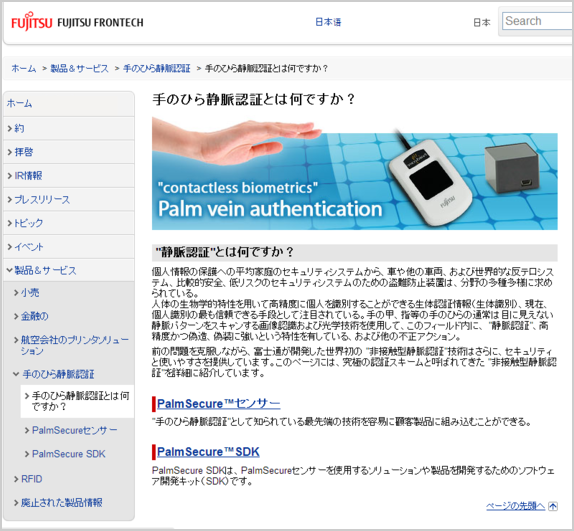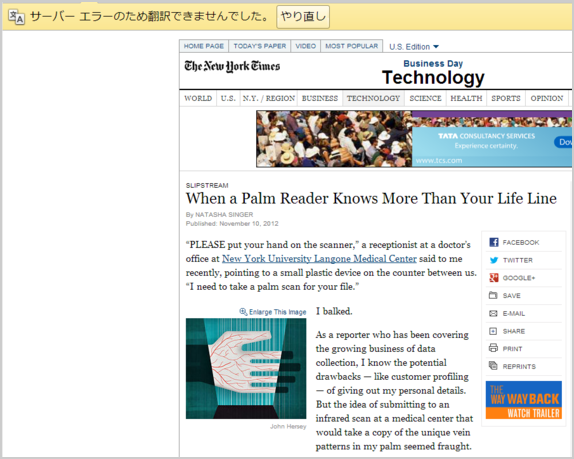The New York Times
ニューヨーク·タイムズ:666は来て
The New York Times: 666 Is Coming
"スキャナに手を入れてください、"ニューヨーク大学ランゴーン医療センターの医師のオフィスでの受付は私たちの間にカウンターの上に小さなプラスチック製のデバイスを指し、最近、私に言った。 "私はあなたのファイルの手のひらスキャンを取る必要があります。"この画像を拡大
“PLEASE put your hand on the scanner,” a receptionist at a doctor’s office at New York University Langone Medical Center said to me recently, pointing to a small plastic device on the counter between us. “I need to take a palm scan for your file.”
Enlarge This Image
ジョン·ハーシー、私は尻込み。
John Hersey I balked.
顧客プロファイリングのような - - 私の個人情報を配ってのデータ収集の成長事業をカバーしている記者として、私は潜在的な欠点を知っている。しかし、私の手のひらにユニークな静脈パターンのコピーを取ると医療センターの赤外線スキャンに提出するのアイデアが満ちたようだ。
As a reporter who has been covering the growing business of data collection, I know the potential drawbacks — like customer profiling — of giving out my personal details. But the idea of submitting to an infrared scan at a medical center that would take a copy of the unique vein patterns in my palm seemed fraught.
受付は、それが自分の利益のためだったと述べた。医療センターでは、彼女は言った、最近、個人情報の盗難から保護するために生体の患者識別システムを制定していた。
The receptionist said it was for my own good. The medical center, she said, had recently instituted a biometric patient identification system to protect against identity theft.
私はしぶしぶマシン上で私の手を立ち往生。私は異議を唱えた場合、私は思った、多分私は医療を拒否されると思います。
I reluctantly stuck my hand on the machine. If I demurred, I thought, perhaps I’d be denied medical care.
次に、受付は、彼女が私の写真を撮るために必要があると述べた。手のひらスキャンした後、それはデータ収集やり過ぎのように思えた。その後、オフィスマネージャーが現れ、スキャンと写真はオプションだったと説明した。悲しいかな、私の手のひらには、システム内に既にあった。
Next, the receptionist said she needed to take my photo. After the palm scan, that seemed like data-collection overkill. Then an office manager appeared and explained that the scans and pictures were optional. Alas, my palm was already in the system.
セキュリティサービスとサイエンスフィクションの映画の省もはや、バイオメトリクス技術が行進である。彼らは自分の写真をアップロードするときにメンバーが自動的に友人の名前タグを置くことができるので、Facebookは顔認識ソフトウェアを使用しています。 Appleは電源シリに音声認識を使用しています。いくつかのテーマパークには、シーズンパスホルダーを認識するためのデジタル指紋を取る。現在、いくつかの病院や学区は、患者や学生を特定し、効率的に管理するために手のひらの静脈パターン認識を使用している 、実際には、EZパスにあなたの手のひらを回す。
No longer the province of security services and science-fiction films, biometric technology is on the march. Facebook uses facial-recognition software so its members can automatically put name tags on friends when they upload their photos. Apple uses voice recognition to power Siri. Some theme parks take digital fingerprints to help recognize season pass holders. Now some hospitals and school districts are using palm vein pattern recognition to identify and efficiently manage their patients or students — in effect, turning your palm into an E-ZPass.
その公共のメンバーは彼らのプライバシーとその利便性のために払っている - しかし、消費者の支持者は、その企業が、ますます利便性を向上させるためにバイオメトリックデータを採用していると言う。
But consumer advocates say that enterprises are increasingly employing biometric data to improve convenience — and that members of the public are paying for that convenience with their privacy.
指紋、顔の寸法や静脈パターンが一意である、消費者の支持者は言う、と慎重に遺伝子サンプルなどとして扱われるべきである。便宜のためにそのような情報を収集するように、彼らが言うには、深刻なアイデンティティの盗難のリスクが増加する可能性があります。しかし、そのようなデータをコンパイルし、企業や機関は、しばしば十分に消費者にリスクを説明するために失敗した、と彼らは言う。
Fingerprints, facial dimensions and vein patterns are unique, consumer advocates say, and should be treated as carefully as genetic samples. So collecting such information for expediency, they say, could increase the risks of serious identity theft. Yet companies and institutions that compile such data often fail to adequately explain the risks to consumers, they say.
"Let 'sは、誰かが偽のIDを作り、中に入り、彼らの写真とあなたのように撮影し、その掌紋を持って言う。あなたが行くときに何をするつもりですか? "パム·ディクソン、世界プライバシーフォーラムのエグゼクティブディレクター、サンディエゴの擁護団体は述べています。 "これをやっている病院は、彼らが実際に彼らのシステムに導入されていることを深いセキュリティの問題を介して跳躍しています。"
“Let’s say someone makes a fake ID and goes in and has their photo and their palm print taken as you. What are you going to do when you go in?” said Pam Dixon, the executive director of the World Privacy Forum, an advocacy group in San Diego. “Hospitals that are doing this are leaping over profound security issues that they are actually introducing into their systems.”
N.Y.U.医療センターは、いくつかの問題に対処するための努力で数年前に生体認証システムの研究を開始した、キャスリン·マクレラン、その新しい電子カルテシステムの導入を担当している、その副社長は語った。ニューヨーク地域で100万人以上が同一または類似の名前を持って、彼女は医療関係者が患者のために間違った健康記録を引き上げるかもしれないというリスクを作成する、と述べた。もう一つの問題は、彼女によると、一部の患者は別の会社で治療を受けてから複数のレコードを持っていたということでした; NYUそれらを統合するための効率的な方法を求めていました。
THE N.Y.U. medical center started researching biometric systems a few years ago in an effort to address several problems, said Kathryn McClellan, its vice president who is in charge of implementing its new electronic health records system. More than a million people in the New York area have the same or similar names, she said, creating a risk that medical personnel might pull up the wrong health record for a patient. Another issue, she said, was that some patients had multiple records from being treated at different affiliates; N.Y.U. wanted an efficient way to consolidate them.
昨年、医療センターでは、各患者は2つのユニークな識別機能を持っているであろうように、写真撮影と手のひらスキャン技術を採用した。さて、氏マクレラン氏によると、各到着患者は彼または彼女の手のひらは、システムが自動的に正しいファイルをプルアップすることができ、スキャンした。
Last year, the medical center adopted photography and palm-scan technology so that each patient would have two unique identifying features. Now, Ms. McClellan said, each arriving patient has his or her palm scanned, allowing the system to automatically pull up the correct file.
"これは、患者の安全の取り組みだ"と氏マクレランは言った。 "我々は、患者への値が巨大だったように感じた。"
“It’s a patient safety initiative,” Ms. McClellan said. “We felt like the value to the patient was huge.”
NYUのシステム、PatientSecureと呼ばれ、タンパのHTシステムによって販売は、すでに25万人以上の患者をスキャンした。米国では、500万人以上の患者がスキャンを持っていた、チャールズYanak、富士通フロンテック北米、富士通、静脈ヤシの識別技術を開発した日本企業の一部門のスポークスマンは言った。
N.Y.U.’s system, called PatientSecure and marketed by HT Systems of Tampa, has already scanned more than 250,000 patients. In the United States, over five million patients have had the scans, said Charles Yanak, a spokesman for Fujitsu Frontech North America, a division of Fujitsu, the Japanese company that developed the vein palm identification technology.

http://www.frontech.fujitsu.com/en/services/palmsecure/what/
しかし、N.Y.U.がある患者でない限りプロセスと不快に見える、さんマクレランによると、医療、登録スタッフは、彼らが写真やスキャンをオプトアウトすることができたことを知らせていない。
Yet, unless patients at N.Y.U. seem uncomfortable with the process, Ms. McClellan said, medical registration staff members don’t inform them that they can opt out of photos and scans.
"我々は正式な同意を持っていない、"マクレラン氏は、先週の火曜日の電話インタビューで語った。
“We don’t have formal consent,” Ms. McClellan said in a phone interview last Tuesday.
それは、プライバシー擁護派のための赤旗を発生させます。 "彼らは、それがオプションである患者に通知していない場合は、"ジョエルReidenberg、データ·プライバシーの専門知識を持つフォーダム大学ロースクール教授は "その後、効果的にそれは同意を強要される"と述べた。
That raises red flags for privacy advocates. “If they are not informing patients it is optional,” said Joel Reidenberg, a professor at Fordham University Law School with an expertise in data privacy, “then effectively it is coerced consent.”
彼が指摘しN.Y.U.医療センターでは、バイオメトリックデータの中心のコレクションは個人情報の盗難の患者のリスクを高めるかもしれないことを示唆して、コンピュータや暗号化されていない患者のデータを含むUSBドライブを紛失したり盗まれたている最近の事件があった。
He noted that N.Y.U. medical center has had recent incidents in which computers or USB drives containing unencrypted patient data have been lost or stolen, suggesting that the center’s collection of biometric data might increase patients’ risk of identity theft.
手のひらスキャンシステムは進数の暗号化された文字列に静脈測定をオンにし、NYUの上に格納されているので、氏マクレランは、個人情報の盗難のほとんどチャンスがあったと回答患者の医療記録とは別のサーバー。違反があった場合でも、一意キーが数値文字列をデコードするために必要とされているので、彼女が追加され、データがハッカーに役に立たないだろう。患者の写真のために、彼女は彼らが彼らの医療記録に添付されている、と述べた。
Ms. McClellan responded that there was little chance of identity theft because the palm scan system turned the vein measurements into encrypted strings of binary numbers and stored them on an N.Y.U. server that is separate from the one with patients’ health records. Even if there were a breach, she added, the data would be useless to hackers because a unique key is needed to decode the number strings. As for patients’ photos, she said, they are attached to their medical records.
それでも、アーサー·カプラン、NYUでの医療倫理の一部門のディレクターセンター、病院が患者に生体認証IDシステムを説明するより良い仕事をすることをお勧めします。彼自身は最近、NYUで約束していたセンターでは、彼が語られ、彼は躊躇して質問をしたまで、手のひらスキャンはオプションであったことを学ぶことがなかった。
Still, Arthur Caplan, the director of the division of medical ethics at the N.Y.U. center, recommended that hospitals do a better job of explaining biometric ID systems to patients. He himself recently had an appointment at the N.Y.U. center, he recounted, and didn’t learn that the palm scan was optional until he hesitated and asked questions.
"それは私にポーズを与えた"と博士はカプランは述べた。 "それは我々は、我々がシステムを通してあなたを追跡するのを助ける生体情報を取得しようとしている 'と言って看板を設置することが有用であろう。あなたがこれを行うにはしたくない場合は、 "'を参照してくださいオフィスマネージャーをしてください。
“It gave me pause,” Dr. Caplan said. “It would be useful to put up a sign saying ‘We are going to take biometric information which will help us track you through the system. If you don’t want to do this, please see’ ” an office manager.
PatientSecure使用する他の機関は、しかし、オプトイン患者のためのプログラムを制定しました。
Other institutions that use PatientSecure, however, have instituted opt-in programs for patients.
デューク大学ヘルスシステムでは、患者がそのオプションを説明するパンフレットを受け取り、Elianaのオーウェンズ、患者の収入の保健システムのディレクター言った。センターはまた、登録デスクでスタッフが患者にオプトイン手のひらスキャンのプロセスについてのスクリプトを読んで訓練し、彼女は言った。 (デュークは、患者の写真を撮ることはありません。)
At the Duke University Health System, patients receive brochures explaining their options, said Eliana Owens, the health system’s director of patient revenue. The center also trains staff members at registration desks to read patients a script about the opt-in process for the palm scans, she said. (Duke does not take patients’ photos.)
"彼らは言う: '登録は任意です。あなたが参加しないことを選択した場合、我々は、その後の訪問であなたの写真付き身分証明書をお願いしていきます、 '"さんオーウェンズは言った。
“They say: ‘The enrollment is optional. If you choose not to participate, we will continue to ask you for your photo ID on subsequent visits,’ ” Ms. Owens said.
同意かどうか、いくつかの主要なアイデンティティの専門家は、今の患者のための手のひらスキャンで少し値を参照してください。医療センターは、独自の制度上の便宜のために患者の生体情報データを使用しようとしている場合、彼らは主張して、センターでは、患者のプライバシーを強化するべきである - によって、言う、その患者がある場合にのみ、個人の医療記録を見て、低エシュロン医療要員を許可する手のひらをスキャンさせることによってアクセスを提示し、承認する。
Consent or not, some leading identity experts see little value in palm scans for patients right now. If medical centers are going to use patients’ biometric data for their own institutional convenience, they argue, the centers should also enhance patient privacy — by, say, permitting lower-echelon medical personnel to look at a person’s medical record only if that patient is present and approves access by having a palm scanned.
それ以外の場合は、 "あなたは危険の別のレベルを可能にしている、"ジョセフ·エイティックは、政府のために相談生体認証IDシステムの先駆者によると、 "代わりにプライバシーの別のレベルを有効にする技術を使用してのでは。"
Otherwise, “you are enabling another level of danger,” said Joseph Atick, a pioneer in biometric identity systems who consults for governments, “instead of using the technology to enable another level of privacy.”
私のリクエスト、N.Y.U.で医療センターでは、私の掌紋が削除されました。
At my request, N.Y.U. medical center has deleted my palm print.
E-メール:。
この記事のバージョンは見出しでニューヨーク版のページBU3に、2012年11月11日にプリントで登場:パームリーダーは、あなたの人生のラインよりも知っているとき。
E-mail:
A version of this article appeared in print on November 11, 2012, on page BU3 of the New York edition with the headline: When a Palm Reader Knows More Than Your Life Line.
